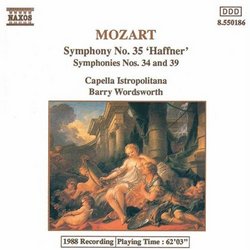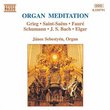| All Artists: Wolfgang Amadeus Mozart, Barry Wordsworth, Capella Istropolitana Title: Mozart: Symphonies Nos. 34, 35 & 39 Members Wishing: 0 Total Copies: 0 Label: Naxos Original Release Date: 1/1/1989 Re-Release Date: 2/15/1994 Genre: Classical Styles: Historical Periods, Classical (c.1770-1830), Symphonies Number of Discs: 1 SwapaCD Credits: 1 UPC: 730099518628 |
Search - Wolfgang Amadeus Mozart, Barry Wordsworth, Capella Istropolitana :: Mozart: Symphonies Nos. 34, 35 & 39
 | Wolfgang Amadeus Mozart, Barry Wordsworth, Capella Istropolitana Mozart: Symphonies Nos. 34, 35 & 39 Genre: Classical
|
Larger Image |
CD DetailsSimilar CDs
|
CD ReviewsGrab this up 11/03/2002 (5 out of 5 stars) "Though I've owned the Naxos boxed set of Mozart symphonies for a few years now, this particular disc has been buried in my CD player for weeks now. While flipping through "The Penguin Guide to Classical Music" a few days ago, I noted that they particularly recommended this disc as an introduction to Wordsworth's facility with this music. I have to concur. This one brings together highly dramatic readings of the Symphony No. 34 (a terse three-movement piece, rather like the earlier "Paris" Symphony in its fast, frothy outer movements) and the "Haffner" along with the epic Symphony No. 39. Wordsworth, as a ballet conductor, shows a happy sense of grace, fantasy, and rhythmic charm. He opens the "Haffner" with a regal display of energetic drama that recalls Szell's bursting treatment of the same music, and the rest of the piece soars along with the same high energy and finesse. Of course, masterful as those earlier works are, the Symphony No. 39 is the most important issue here, and it may confidently be offered that Wordsworth and his players evoke its gorgeous, "Magic Flute"esque world of wintry, fairy-tale charm, menace, and romance with loving devotion. Though one must lament the absence of repeats for the final movement, this remains a wonderful statement of this music from start to finish. Trustfully Naxos will keep pumping these out; while the eccentric, scholarly genius of Harnoncourt and Mackerras is beyond dispute, people also require more traditional (or "traditional") presentations of this immortal music, and Wordsworth has easily bested Marriner here at this game." The Fire and the Agonies Leslie Richford | Selsingen, Lower Saxony | 12/15/2004 (5 out of 5 stars) "This CD is something of a highlight in the Naxos catalogue. Barry Wordsworth?s Mozart interpretations have all been given praise enough, but this 1988 recording of three of Mozart?s most moving and entertaining symphonies is the best of the whole lot. Neither the acoustics nor the audio engineering are perfect, but both are more than adequate and make for 62 minutes of sheer enjoyment, with Wordsworth coaxing the very best out of his Slovakian musicians and enabling the listener to follow with great pleasure all the ins-and-outs and ups-and-downs of Mozart?s lively scores. In particular, I felt that Symphony No. 39 was quite brilliant, and comparing Wordsworth?s interpretation with the latest budget competition on Warner?s Apex label (Ton Koopman directing the Amsterdam Baroque Orchestra), I have to say that Wordsworth more than holds his own: on the one hand, Koopman and his period-performance troupe have the advantage of more spacious, transparent engineering, but on the other hand I felt that Wordsworth?s was the more energetic, perhaps even more Mozartean recording, with Koopman going for a soft-touch noblesse that somehow seemed to lack both the fire and the agonies that Wordsworth allows the score to express. With the ?Haffner? (Symphony No. 35), I would give Nikolaus Harnoncourt and the Concertgebouw Orchestra slightly better marks, but here too I think Wordsworth does a fine job." Enjoyable Performances JohnL | Alexander, NC United States | 12/17/2001 (5 out of 5 stars) "These three Mozart symphonies are combined on one budget-priced CD, and this is not only a bargain, but these are very enjoyable and refreshing. Especially one of Mozart's last symphonies, K.543 (Number 39) in E flat, with the very crisp and dramatic hard-stick timpani at the very opening of the first movement. Barry Wordsworth and the Capella Istropolitana are worthy performers, and this recording, along with 12 other Mozart symphonies on four Naxos CDs, are a very good way to get all of the most famous symphonic works of W.A. Mozart; with a very modest outlay."
|

 Track Listings (11) - Disc #1
Track Listings (11) - Disc #1